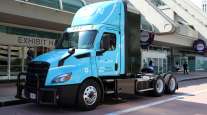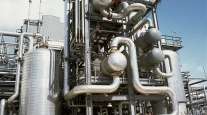High Cost of Hydrogen Remains a Drag on Adoption

[Stay on top of transportation news: Get TTNews in your inbox.]
If hydrogen fuel cell technology is going to become a desired and viable electric vehicle power source, the cost will have to come down.
It isn’t so much the cost of the vehicles standing in the way of hydrogen-powered trucks and other vehicles. It’s the cost of the hydrogen fuel itself, which in California is generally priced at about $25 per kilogram. At that price point, it would cost about $135 to fill up a standard car.
“That is not really price competitive,” said Thiemo Schalk, a representative for the government and external affairs division for BMW of North America, during a panel at the California Hydrogen Leadership Summit in June.
“If we don’t get the hydrogen price down, [even] if we give free trucks away, people will not start using it because it doesn’t make any sense for them,” agreed Rick Breunesse, business development director at Symbio North America, maker of light and heavy-duty hydrogen vehicle technology.
Hydrogen fuel needs to be priced closer to $10 per kilo, said Pat Griffin, president of North America at Hyzon Motors, maker of heavy-duty hydrogen-powered vehicles.
“[Fleet customers] say, ‘I can bear that today. When can I get to $6?’ And that seems to be the next number I’m hearing,” he added.
Hydrogen has been touted as the most sensible fuel option for zero-emission heavy-duty vehicles like freight trucks and even locomotives and ships. The development of hydrogen-powered transportation is especially relevant as states like California adopt mandates requiring the conversion of trucking and fleets to zero-emission vehicles.
Thank you to the California Hydrogen Leadership Summit for bringing together key officials and trailblazers in the hydrogen and fuel cell industry today in Sacramento. Nikola's actions are focused on leading this shift towards decarbonization and a zero-emission future. pic.twitter.com/XYSp6nKgxh — Nikola Motor Company (@nikolamotor) June 20, 2023
Hydrogen’s advantage over battery-electric power is because of the longer ranges it enables, as well as lighter overall weight since the vehicles are not burdened with huge, heavy batteries. However, for the technology to truly gain traction, hydrogen production will need to increase, and an infrastructure network is needed to store the fuel and establish refueling stations, industry watchers note.
“What we’ve seen here today, with a lot of the infrastructure efforts going on, is really encouraging, and it can’t come soon enough,” said Griffin.

The makers of Transport Topics’ updated Top 100 For-Hire Carriers list examine trucking’s shifting business environment and what it means for the supply chain. Tune in above or by going to RoadSigns.ttnews.com.
“If we wait for the volume of trucks to be in place before we invest in our infrastructure, it’s too late. It’s not going to succeed, and we’ll all fail. So they have to be coming together simultaneously,” he added.
Incentives are also needed to move the infrastructure and vehicles into the market, said California state Sen. Bob Archuleta, whose district includes portions of Los Angeles and Orange counties.
“These incentives can stimulate research and development, infrastructure expansion, and the deployment of clean hydrogen technology,” Archuleta told the summit.
Want more news? Listen to today's daily briefing below or go here for more info:
Distributed by Tribune Content Agency, LLC




